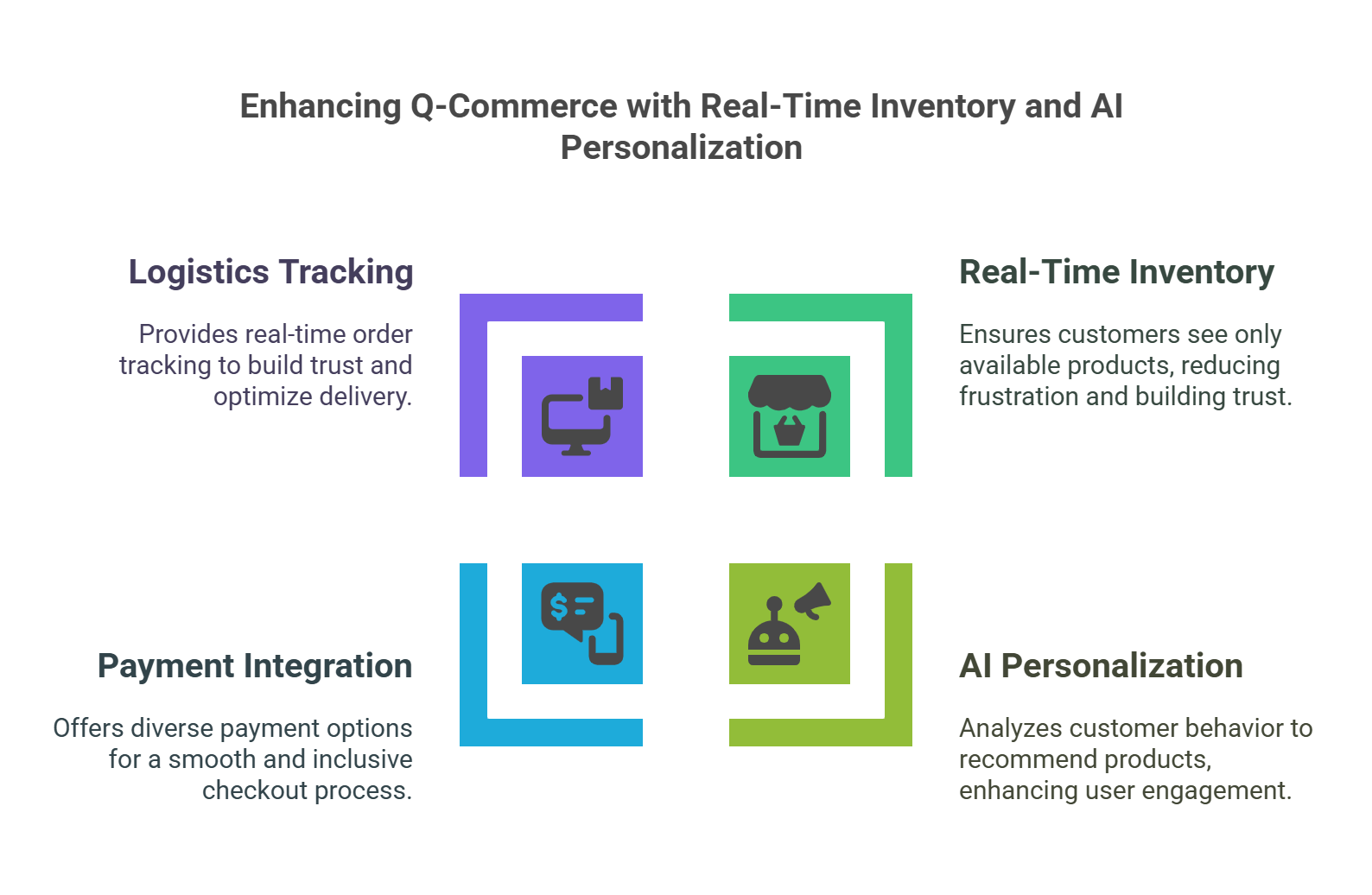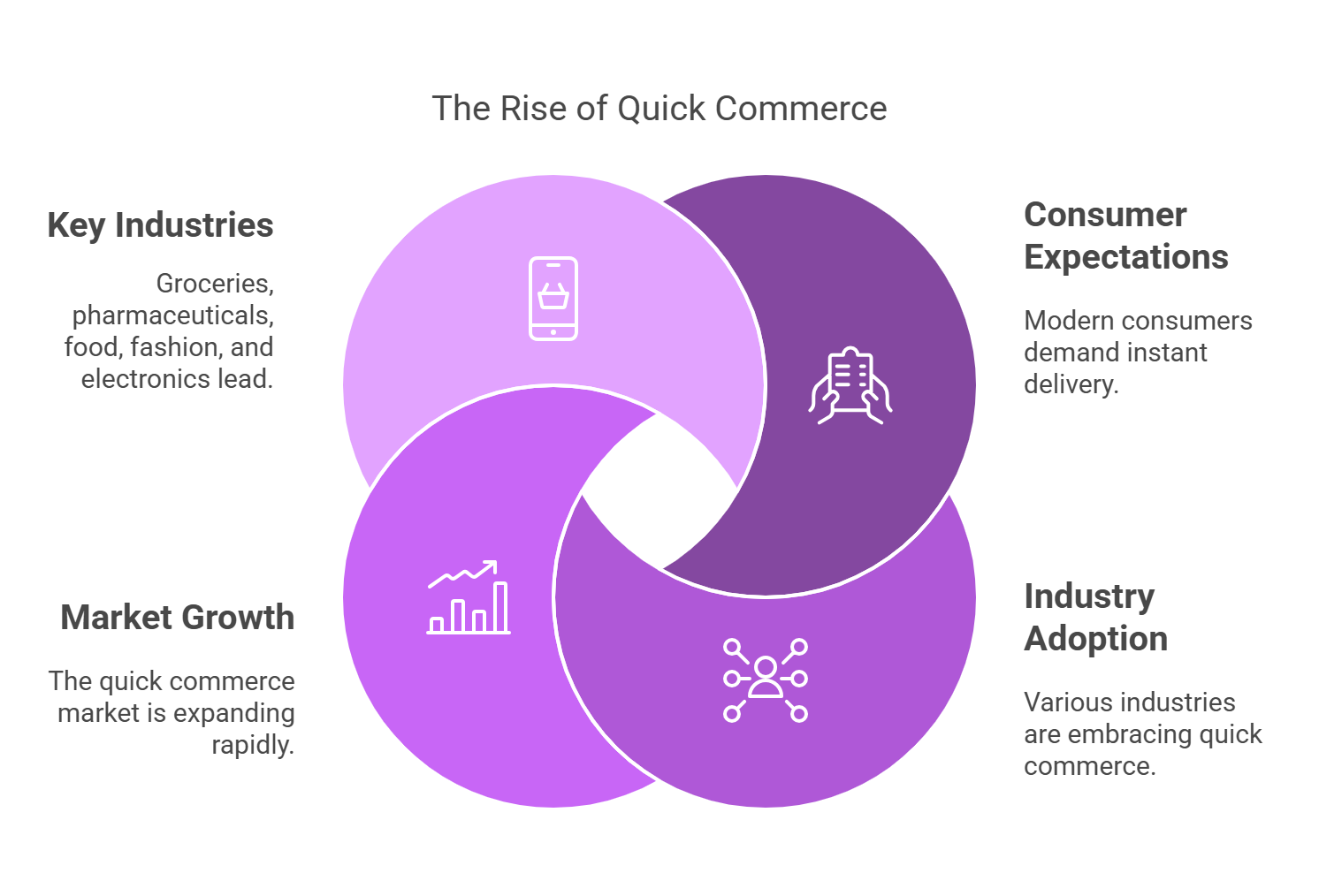Businesses have now modified their operations for today’s world that leaves little room for comfort, but rather makes speed become an expectation. Modern consumers required almost an immediate delivery of what they needed, thus bringing up an idea of quick commerce. Q-commerce is setting its muscle to change the design in the delivery of products, specifically orders delivery from 10-30 minutes.
It’s bringing a whole new ballgame for companies with a speedy delivery model, relying heavily on smart logistics as a core ingredient. Using quick commerce app development, companies will be able to meet the demands of customers in a timely fashion, improve their internal inventory management, and streamline delivery processes.
The introduction of a quick commerce app didn’t happen by mere coincidence. It is a cumulative result of attitudinal shifts, technological advancements, and the growing pressure to differentiate business within a competitive milieu. What creates the demand for this hyped trend, and what has made many companies change their mind? Going on, we analyze that.
The Rise of Quick Commerce Mobile Apps
For a long time, shopping has become an expression of faster experiences, but now technology has enabled fulfillment at a previously unimaginable speed. Quick commerce software is gaining traction since it caters to both the current consumer and businesses that want to stay ahead.
Among the main reasons for its rise is increasing expectation of speed. With busy lives, modern consumers want their purchases to be delivered almost instantly. Research conducted by customer experience expert Jay Baer emphasizes the centrality of speed in customer satisfaction and loyalty. Baer discovered that two-thirds of consumers weigh speed equally against price, urging companies to guarantee fast delivery.
Groceries top the list of products typically sold through quick commerce. Other industries have not been left behind, the likes of pharmaceuticals, food, fashion, and electronics joining the bandwagon to catch up with meeting customer needs and improving operations.
The figures illustrate the swift growth of quick commerce. The market is expected to produce revenues of $62.63 billion in 2025, with a CAGR of 6.94% between 2025 and 2029. By 2029, the market will reach $81.91 billion, showing the footprint that q-commerce has in reshaping fulfillment among businesses to address customer demands.
How Q-Commerce Is Improving Operational Business Efficiency
Businesses are adopting quick commerce not just for customer satisfaction but also for streamlining operations. Here’s how:
Faster Order Processing
Technology has revolutionized corporate operations, with AI-based solutions leading the way in order fulfillment. They automate various steps of the order process, from placing the order to delivery, thus minimizing the risk of human error. By streamlining operations, these firms can process the order quicker and much more accurately, providing an effortless customer experience.
Intelligent warehouses also contribute to enhancing efficiency. These warehouses boast advanced inventory management systems that ensure optimized stock levels and prompt access to products. With diligent coordination between inventory and order fulfillment, businesses provide their customers with speed and precision.
Automated Inventory Management
Q-commerce platforms leverage AI-driven systems to optimize inventory management under countless scenarios and conditions, ensuring accurate forecasting. They analyze factors such as seasonal trends, customer preferences, and purchasing behaviors to help businesses avoid stockouts or overstocking.
Additionally, automation of inventory management reduces the need for manual intervention, saving time and minimizing operating costs. This enables companies to keep an effective and well-structured inventory model while allocating resources to other important areas. With such streamlined processes, quick commerce platforms enable businesses to operate with greater precision and scalability.
Optimized Last-Mile Delivery
The real-time GPS tracking system has optimized the last-mile delivery. By determining the best routes possible, an organization can avoid holdups to deliver goods faster to its clients. It ensures dependability in deliveries yet creates an optimum approach in operation with respect to deliveries.
Dynamic scheduling further improves its efficiency through route changes and scheduling adjustments based on real-time conditions such as traffic situations as well as demand seriousness. This system decreases fuel use and delivery time, thus resulting in reductions of operation costs on its way to sustainability with respect to customer satisfaction.
Cost Reduction
By managing processes like order processing, inventory control, and delivery scheduling with little assistance from humans, automation significantly lowers labor expenses. This streamlining of operations allows businesses to allocate resources more efficiently while lowering expenses.
Additionally, by improving accuracy and efficiency in order fulfillment and delivery, businesses experience fewer delivery failures. This reduces the need for refunds and costly re-deliveries, further cutting operational costs and boosting overall profitability.
Key Features of Successful Q-Commerce Apps
Real-Time Inventory Tracking
The perfect q-commerce application is one where the customer sees only products currently available on the app, and real-time visibility avoids the frustration of customers searching for out-of-stock items while creating trust with accurate stock availability.
AI-Powered Personalization
The present-day q-commerce applications base their artificial intelligence on behavior and preference analysis of customers. This is then used to recommend items according to individual tastes and thus create a personalized shopping experience, which leads to more user engagement and increased sales. Leveraging a quick commerce software platform simplifies the development process, enabling businesses to integrate AI-driven recommendations seamlessly and enhance customer satisfaction.

Seamless Payment Integration
The app offers a carefully designed range of payment modes, including UPI, digital wallets, credit and debit cards, and cash-on-delivery. This variety of payment choices simplifies the checkout process, catering to a wide customer base and assuring a smooth, hassle-free purchasing experience.
Robust Logistics & Delivery Tracking
Real-time tracking of orders allows customers to observe their deliveries live, creating trust, but delivering an open process as well. The movement optimization accelerates delivery and minimizes operation costs. The improvement results in consumer confidence and efficiency of the app as a whole.
Conclusion
Speeding up the retail industry, quick commerce has made its spot. The businesses switching to a mobile-first approach really thrived and gained faster fulfillment, together with cheaper costs and improved operational workflows. With real-time inventory tracking, the stampede into higher accuracy and stock-improved prevention issues sets its standard for smooth supply chain movement.
Also, new rates have been set concerning customer satisfaction through personalized experience and seamless service delivery. Q-commerce is set to grow further as technology advances, providing opportunities for ever-greater innovations.
Investing in this exciting and promising model today would not only keep businesses in the race but will also lead them to become the leaders of the fast-paced retail future.
